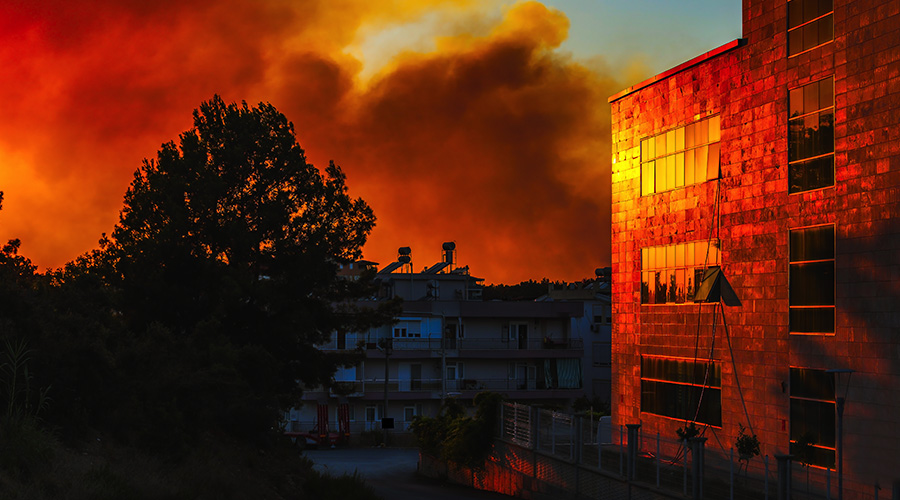In Case of Emergency, Show Occupants the Door
Photoluminescent signs and markings glow in the dark, without electricity, to provide a reliable path to exits.
When the electricity goes out and a building must be evacuated, photoluminescent technology could be the guiding light that leads tenants to safety. Used for years in passenger aircraft, marine and other transportation applications, photoluminescent technology has moved into the facility arena in the past few years. Powered only by ambient light, photoluminescent safety signs and path markers glow in the dark similar to children’s novelty decals found at any craft store but at a much higher level.
“The purpose of photoluminescent technology is not the illumination of a space,” says Jim Amy, senior consultant with Rolf Jensen & Associates. “The purpose is to provide definition of a space so people can orient themselves. Photoluminescent material marks the leading edge of the steps. It marks the landing, and it marks the handrails. Your mind kind of fills in the blanks so you can orient yourself. It’s like cutting off the bottom of a word. You can’t see all of it, but you know what’s supposed to be there.”
Photoluminescent technology offers advantages over electrically wired exit signs and emergency lighting. One is reliability. Because the glow is a chemical reaction, an adequately charged sign will not fail.
“It is 100 percent reliable,” Amy says. “You can’t stop it from performing if it is charged. And it is being charged by lighting that would normally be on anyway. You’re not depending on electrically powered systems during an emergency, and you’re not depending on a charged battery.”
It also saves energy. Charged by existing light, photoluminescent technology is the first Energy Star program with zero energy consumption, says Al Carlson, chairman of the International Photoluminescent Safety Product Council and vice president of Jessup Manufacturing.
New York City code
Its high reliability factor is the main reason New York City has established a new city ordinance requiring all buildings over 75 feet tall to install photoluminescent safety systems.
Local Law 26 of 2004, passed last fall, requires that photoluminescent signs be installed on doors leading to exits and photoluminescent markings be installed in exit stairs, says Michael Rzeznik, manager of Schirmer Engineering’s New York office.
Rzeznik says the changes were the result of recommendations by the city’s World Trade Center Building Code Task Force. Among other things, the task force reviewed operating requirements and determined what modifications were needed in new and existing buildings to ensure public safety during extreme events. The recommendation for photoluminescent technology stemmed in part from failure of emergency battery-powered backup lighting during the first bombing of the World Trade Center in 1993.
The new law says that photoluminescent systems must be in place by July 2006. The measure applies to all high-rise buildings regardless of when they were built, Rzeznik says.
Regulations that will implement the new law are currently being developed, says Geoffrey Peckham, president of Jalite USA and a member of the task force looking into implementation standards. Among the issues involved are the configuration of photoluminescent components — where they should appear and what they should look like — and the physical properties of the photoluminescent materials.
Though photoluminescent safety markings are similar in concept to glow-in-the-dark decals, experts say there is a significant performance difference between commercial-grade and novelty-grade material.
Commercial-grade phosphorus holds energy for hours, though a majority is given off in the first 10 minutes. “The luminance may decrease, but it does so as your eyes are adapting to the darkness, compensating for the dimming of the sign in the first 40 or so minutes,” Amy says.
Strontium oxide aluminate, a pigment introduced in 1995, has vastly improved product quality. The pigment can be contained in materials like ceramic, plastic, tape and even paint. The strength of the material’s charge depends on three things: the type of available light, the intensity of the light, and how long the light is on, Amy says.
Fluorescent and halogen lights charge the material better than incandescent light. Sunlight charges the material well but causes deterioration over time.
Photoluminescent markers should be placed near or on the floor. Because smoke rises, positioning the markers close to or on the floor allows occupants to find their way even if they must exit on hands and knees. On the floor, the exit path should be illuminated with a continuous piece of material, says Amy. On the wall, it should be continuous except as the exit path is interrupted by doors.
‘This stuff glows’
The amount of material used depends on how much available light is present and how much afterglow is expected. If the passageway is 2 meters (6.5 feet) or more wide, the material should be placed on both walls.
A study by the Institute for Research in Construction, part of Canada’s National Research Council, showed that occupants who were not familiar with stairwell conditions could evacuate a stairwell marked by photoluminescent wayfinding systems as quickly as counterparts could in a fully lighted stairwell.
According to the study, “Effectiveness of a Photoluminescent Wayguidance System,” occupants are comfortable with photoluminescent material (PLM) signs and a wayguidance system in stairwells without any other illumination source. “The majority of the occupants who participated in the experiment encountered the PLM signs and wayguidance system for the first time,” the study says. “Exclamations of people who first opened the door to Stairwell C were recorded on the videotapes; some said, ‘Gee, it is dark in here,’ others, ‘Wow, this stuff glows.’ On two occasions, a brief hesitation was observed before the person entered the stairwell, but nobody refused to leave and most people just followed the evacuation flow. These observations are important since this material is fairly unknown to most North Americans.”
Photoluminescent systems must be steadily lighted to be effective. “They don’t belong in a space not normally lighted or in some spaces controlled by motion-activated lighting sensors,” Amy says.
When it comes to photoluminescent systems, it’s important to distinguish between unlighted space and dimly lit space. While the technology is ideal for places such as hospitals and commercial office spaces, it also can be used in movie theaters and stadiums. Markers are charged enough when the lights are on so that they still glow but are not intrusive.
Role of photoluminescence
New York isn’t the only place that has looked into the issue of mandating photoluminescent markings and signs in high rises. In New Jersey, for example, state legislators are considering a change in the state building code to require photoluminescent systems in all high rises, according to Amy. He says that the idea has also come up in Chicago.
Those developments raise the question of whether photoluminescent systems should be used in all high-rise buildings. Daniel O’Connor, Schirmer Engineering’s vice president of engineering, doesn’t go that far. He says the usefulness of photoluminescent technology depends on the occupancy and life-safety features in a building.
“Current codes address the concerns for reliable lighting by requiring emergency lighting provisions,” O’Connor says. These codes often require many other safety features — sprinklers, smoke detection, smoke exhaust and emergency power — to provide a high degree of assurance that the spread of fire and smoke are limited, that people are warned of an emergency, and that egress routes are reliably lighted. “Photoluminescent technology may play a role for some buildings that lack some of these important features,” he says.
O’Connor doesn’t believe photoluminescent systems should be required in new buildings as a backup to traditional emergency lighting. Rather, he says, photoluminescent systems should be evaluated as an alternative to electrically powered emergency lighting.
In the past, photoluminescent technology was allowed only as a backup to electrically powered emergency lighting, Amy says. But he says he believes photoluminescent technology will increasingly be approved as an alternative to electric systems. “It has been accepted in some places, and I think it will continue to be accepted.”
But Amy sees benefits to photoluminescent systems being used in tandem with electrically powered systems. “Even in a fully lighted building, it reinforces the right path,” he says. “I think it can be helpful.”
In any evaluation of photoluminescent technology, O’Connor says, both the benefits and the costs of those systems must be weighed, and he points out that the photoluminescent material itself accounts for only part of the overall installation cost. Aesthetic considerations may lead to interior finish modifications and other changes that could cost more than the material itself.
Carlson expects interior designers to become more creative with the technology as it becomes more widespread.
The results of the Canadian study demonstrated that facility executives should educate occupants on evacuation procedures. That education should include photoluminescent systems. If the lights are out, occupants will see the glowing markers and understand what they are. “It’s very clear,” says Amy. “But if there is lighting and the occupants don’t know what pathway marking is, they may not notice it. They may not identify it as a help to finding their way out.”
Lynn Proctor Windle, a contributing editor to Building Operating Management, is a freelance writer who has written extensively about real estate.
What to do before the alarm goes off
When emergency alarms sound, it is critical that building occupants know how to respond.
“The first thing that key management needs to do is be upfront with the development of plans so that occupants know that there are different types of evacuations,” says Mark Hankewycz, senior manager for Gage Babcock’s security services. Not every evacuation alarm is a call to leave the building. Some events, like severe storms, require evacuation to a shelter within the building. When the alarm goes off, occupants should know from its sound and cadence what type of evacuation is required.
Next, they should know where they’re going. If the alarm calls for occupants to leave the building, they must know their egress routes and where to meet once they’re outside.
Occupants should have this information prior to any emergency, says Jon Evenson, senior consultant, Sako & Associates. He advises facility executives to develop handouts that include information like floor maps, directions on what to do, and the meanings of warning signs and sounds. “We don’t want occupants to hesitate or panic in an emergency,” he says.
When there is an emergency, occupants need to know where to turn for immediate information and directions. Each floor should have a floor warden and an alternate, someone trained in various emergency scenarios. Occupants should understand that floor wardens are in communication with building management. Everyone should be aware of who these people are and that occupants must follow their directions, Hankewycz says.
Occupants also should know to listen for the building’s intercom system. If necessary, the fire department will tap into this system to address occupants directly.
Evacuation plans should be as simple and direct as possible. The ultimate goal is for building occupants to understand their role in an evacuation and to take that role seriously. “We’re not looking for anyone to be a hero,” Evenson says. “Building occupants must know who to get information from and how to get out.”
|
Related Topics:











